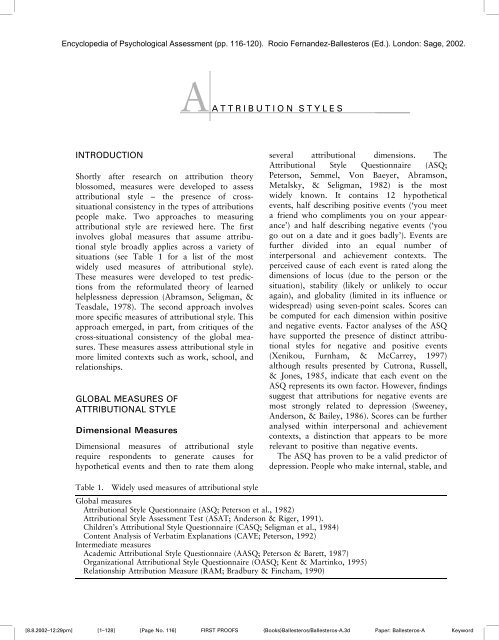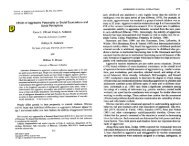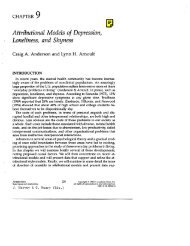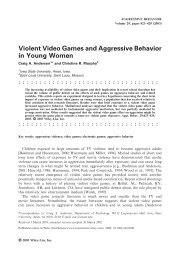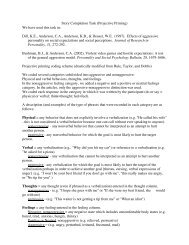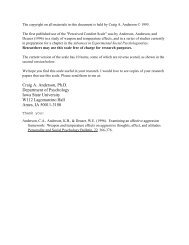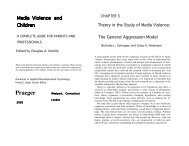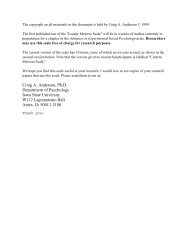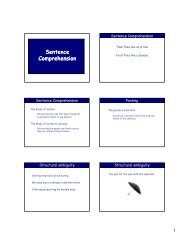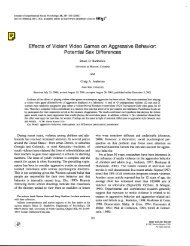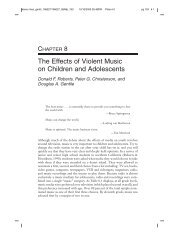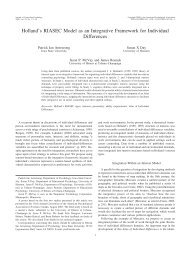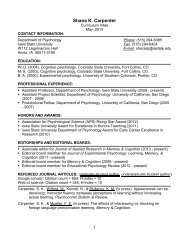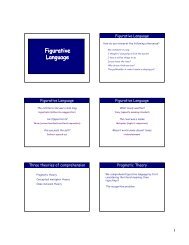Measures of attributional style
Measures of attributional style
Measures of attributional style
You also want an ePaper? Increase the reach of your titles
YUMPU automatically turns print PDFs into web optimized ePapers that Google loves.
Encyclopedia <strong>of</strong> Psychological Assessment (pp. 116-120). Rocio Fernandez-Ballesteros (Ed.). London: Sage, 2002.<br />
AA TTRIBUTION STYLES<br />
INTRODUCTION<br />
Shortly after research on attribution theory<br />
blossomed, measures were developed to assess<br />
<strong>attributional</strong> <strong>style</strong> – the presence <strong>of</strong> crosssituational<br />
consistency in the types <strong>of</strong> attributions<br />
people make. Two approaches to measuring<br />
<strong>attributional</strong> <strong>style</strong> are reviewed here. The first<br />
involves global measures that assume <strong>attributional</strong><br />
<strong>style</strong> broadly applies across a variety <strong>of</strong><br />
situations (see Table 1 for a list <strong>of</strong> the most<br />
widely used measures <strong>of</strong> <strong>attributional</strong> <strong>style</strong>).<br />
These measures were developed to test predictions<br />
from the reformulated theory <strong>of</strong> learned<br />
helplessness depression (Abramson, Seligman, &<br />
Teasdale, 1978). The second approach involves<br />
more specific measures <strong>of</strong> <strong>attributional</strong> <strong>style</strong>. This<br />
approach emerged, in part, from critiques <strong>of</strong> the<br />
cross-situational consistency <strong>of</strong> the global measures.<br />
These measures assess <strong>attributional</strong> <strong>style</strong> in<br />
more limited contexts such as work, school, and<br />
relationships.<br />
GLOBAL MEASURES OF<br />
ATTRIBUTIONAL STYLE<br />
Dimensional <strong>Measures</strong><br />
Dimensional measures <strong>of</strong> <strong>attributional</strong> <strong>style</strong><br />
require respondents to generate causes for<br />
hypothetical events and then to rate them along<br />
several <strong>attributional</strong> dimensions. The<br />
Attributional Style Questionnaire (ASQ;<br />
Peterson, Semmel, Von Baeyer, Abramson,<br />
Metalsky, & Seligman, 1982) is the most<br />
widely known. It contains 12 hypothetical<br />
events, half describing positive events (‘you meet<br />
a friend who compliments you on your appearance’)<br />
and half describing negative events (‘you<br />
go out on a date and it goes badly’). Events are<br />
further divided into an equal number <strong>of</strong><br />
interpersonal and achievement contexts. The<br />
perceived cause <strong>of</strong> each event is rated along the<br />
dimensions <strong>of</strong> locus (due to the person or the<br />
situation), stability (likely or unlikely to occur<br />
again), and globality (limited in its influence or<br />
widespread) using seven-point scales. Scores can<br />
be computed for each dimension within positive<br />
and negative events. Factor analyses <strong>of</strong> the ASQ<br />
have supported the presence <strong>of</strong> distinct <strong>attributional</strong><br />
<strong>style</strong>s for negative and positive events<br />
(Xenikou, Furnham, & McCarrey, 1997)<br />
although results presented by Cutrona, Russell,<br />
& Jones, 1985, indicate that each event on the<br />
ASQ represents its own factor. However, findings<br />
suggest that attributions for negative events are<br />
most strongly related to depression (Sweeney,<br />
Anderson, & Bailey, 1986). Scores can be further<br />
analysed within interpersonal and achievement<br />
contexts, a distinction that appears to be more<br />
relevant to positive than negative events.<br />
The ASQ has proven to be a valid predictor <strong>of</strong><br />
depression. People who make internal, stable, and<br />
Table 1. Widely used measures <strong>of</strong> <strong>attributional</strong> <strong>style</strong><br />
Global measures<br />
Attributional Style Questionnaire (ASQ; Peterson et al., 1982)<br />
Attributional Style Assessment Test (ASAT; Anderson & Riger, 1991).<br />
Children’s Attributional Style Questionnaire (CASQ; Seligman et al., 1984)<br />
Content Analysis <strong>of</strong> Verbatim Explanations (CAVE; Peterson, 1992)<br />
Intermediate measures<br />
Academic Attributional Style Questionnaire (AASQ; Peterson & Barett, 1987)<br />
Organizational Attributional Style Questionnaire (OASQ; Kent & Martinko, 1995)<br />
Relationship Attribution Measure (RAM; Bradbury & Fincham, 1990)<br />
[8.8.2002–12:29pm] [1–128] [Page No. 116] FIRST PROOFS {Books}Ballesteros/Ballesteros-A.3d Paper: Ballesteros-A Keyword
Attribution Styles 117<br />
global attributions for negative events tend to be<br />
more depressed. However, there are at least four<br />
problems with the ASQ. First, internal consistency<br />
for the ASQ ranges from adequate to low,<br />
especially for the locus dimension. A frequent<br />
solution is to combine the three dimensions into<br />
a single index to increase reliability, as the<br />
dimensions tend to correlate highly with one<br />
another. However, this creates a second problem<br />
one <strong>of</strong> interpretation. There are unique predictions<br />
for each <strong>attributional</strong> <strong>style</strong> dimension; using<br />
a composite score prevents valid tests <strong>of</strong> the<br />
model (Carver, 1989). Reivich (1995) advises<br />
researchers to analyse ASQ data in terms <strong>of</strong> both<br />
individual dimensions and composite scores. The<br />
third problem is also related; the ASQ does not<br />
assess the key <strong>attributional</strong> dimension <strong>of</strong> controllability.<br />
The few studies that included<br />
controllability consistently find that it is the<br />
most important <strong>attributional</strong> <strong>style</strong> dimension,<br />
whereas globality is the least important (e.g.<br />
Deuser & Anderson, 1995). The fourth problem<br />
concerns the affiliation versus achievement<br />
distinction; several <strong>of</strong> the ‘achievement’ items<br />
involve affiliative contexts. The Expanded<br />
Attributional Style Questionnaire (EASQ;<br />
Peterson & Villanova, 1988) uses an identical<br />
format to the ASQ and addresses the problem <strong>of</strong><br />
low reliability by increasing the number <strong>of</strong><br />
situations included in the measure. However,<br />
reliabilities remain modest and the other problems<br />
remain unresolved.<br />
The third and fourth versions <strong>of</strong> the<br />
Attributional Style Assessment Test (ASAT-III<br />
and ASAT-IV) provide another dimensional<br />
assessment <strong>of</strong> <strong>attributional</strong> <strong>style</strong> (Anderson &<br />
Riger, 1991). These measures use a format<br />
similar to the ASQ but they incorporate a<br />
larger number <strong>of</strong> items (20 for the ASAT-III<br />
and 36 for the ASAT-IV), include the controllability<br />
dimension, and use success and failure<br />
items that mirror each other (e.g. ‘succeeded’ vs.<br />
‘failed’ at coordinating an outing for a group <strong>of</strong><br />
people...). The interpersonal versus noninterpersonal<br />
subsets <strong>of</strong> items are more clearly differentiated<br />
than the affiliation versus achievement<br />
items <strong>of</strong> the ASQ. Internal reliabilities at the<br />
subscale level tend to be weak to modest, in<br />
the 0.5–0.6 range; collapsing across situation<br />
types (e.g. ignoring the interpersonal vs. noninterpersonal<br />
distinction) yields somewhat larger<br />
alphas. These scales have successfully predicted<br />
depression, loneliness, and shyness as well as<br />
depressive-like motivational deficits in laboratory<br />
settings. Furthermore, this body <strong>of</strong> work has<br />
demonstrated the importance <strong>of</strong> assessing <strong>attributional</strong><br />
<strong>style</strong>s separately for interpersonal and<br />
noninterpersonal situations. Finally, this work<br />
has shown substantial correlations between<br />
<strong>attributional</strong> <strong>style</strong>s for successful events and<br />
depression (and loneliness and shyness).<br />
Several other dimensional measures <strong>of</strong> <strong>attributional</strong><br />
<strong>style</strong> use the same basic approach as the<br />
ASQ and ASAT. The Balanced Attributional<br />
Style Questionnaire (BASQ; Feather &<br />
Tiggemann, 1984) uses a format similar to the<br />
ASQ but, like the ASAT, the positive and<br />
negative items mirror one another. The scales<br />
have moderate reliabilities and correlate with<br />
depression, self-esteem, and protestant work<br />
ethic. The Real Events Attributional Style<br />
Questionnaire (REASQ; Norman & Antaki,<br />
1988) requires that respondents generate the<br />
positive and negative events for which they then<br />
make attributions. This may yield a better<br />
prediction <strong>of</strong> depression, but the loss <strong>of</strong> item<br />
standardization creates other problems.<br />
Forced-Choice <strong>Measures</strong><br />
Forced-choice measures have respondents select a<br />
cause from a list <strong>of</strong> potential explanations. One<br />
benefit is that this method may more accurately<br />
mirror how people typically select a cause (i.e.<br />
without thinking about dimensions). Also, the<br />
types <strong>of</strong> causes in the list can be restricted to only<br />
those attributions <strong>of</strong> theoretical interest. Forcedchoice<br />
measures also require less time to<br />
complete.<br />
The ASAT-I and ASAT-II use this forced<br />
choice format. Respondents are provided with a<br />
number <strong>of</strong> hypothetical situations (20 for the<br />
ASAT-I and 36 for the ASAT-II). On the ASAT-<br />
I, the listed types <strong>of</strong> causes are strategy, ability,<br />
effort, personality traits, mood, and circumstances.<br />
ASAT-II includes only strategy, effort,<br />
and ability causes. The number <strong>of</strong> times a<br />
particular cause is selected is summed to create a<br />
measure <strong>of</strong> <strong>attributional</strong> <strong>style</strong> for that dimension.<br />
Kuder–Richardson (K-R 20) reliabilities for<br />
the subscales tend to be in the low to moderate<br />
range. Correlations with loneliness and depression<br />
have established the validity <strong>of</strong> these<br />
[8.8.2002–12:29pm] [1–128] [Page No. 117] FIRST PROOFS {Books}Ballesteros/Ballesteros-A.3d Paper: Ballesteros-A Keyword
118 Attribution Styles<br />
scales in both U.S. and Mainland China college<br />
student populations (Anderson, 1999). 1<br />
<strong>Measures</strong> For Children<br />
The Children’s Attributional Style Questionnaire<br />
(CASQ; Seligman et al., 1984) was developed to<br />
allow researchers to study <strong>attributional</strong> <strong>style</strong> in<br />
children ages 8–13. The CASQ includes 48 items<br />
divided equally between positive (‘You get an<br />
‘‘A’’ on a test’) and negative events (‘You break a<br />
glass’). The scale uses both a forced choice and<br />
a dimensional approach. Respondents select<br />
between two possible causes for the event, and<br />
each option represents the presence or absence <strong>of</strong><br />
one attribution dimension (for example, an<br />
internal or external cause). Attributions for each<br />
dimension are computed by summing the number<br />
<strong>of</strong> internal, stable, or global responses. Scores<br />
similar to the ASQ can then be computed.<br />
Internal consistency <strong>of</strong> the CASQ is low to<br />
adequate and improves when the separate<br />
dimensions are combined into a single composite.<br />
Content Analysis Measure<br />
The Content Analysis <strong>of</strong> Verbatim Explanations<br />
(CAVE; Peterson, 1992) technique assesses<br />
<strong>attributional</strong> <strong>style</strong> through a content analysis <strong>of</strong><br />
an individual’s writing. This allows analysis <strong>of</strong><br />
ecologically valid events without requiring the<br />
participant to complete a questionnaire. The<br />
CAVE can also be applied to historical data, and<br />
it has established the stability <strong>of</strong> <strong>attributional</strong><br />
<strong>style</strong> over a 52-year period (Burns & Seligman,<br />
1989). Coders first extract causal explanations<br />
from a text, then rate them along the dimensions<br />
<strong>of</strong> locus, stability, and globality. Inter-rater<br />
reliability for the CAVE technique is satisfactory,<br />
and internal consistency has been reported as low<br />
to adequate. More standard questionnaire measures<br />
<strong>of</strong> <strong>attributional</strong> <strong>style</strong> may be better<br />
predictors <strong>of</strong> depression, but the CAVE technique<br />
has proven useful when written content is all that<br />
is available.<br />
INTERMEDIATE MEASURES OF<br />
ATTRIBUTIONAL STYLE<br />
Global measures <strong>of</strong> <strong>attributional</strong> <strong>style</strong> assume a<br />
high degree <strong>of</strong> cross-situational consistency in the<br />
types <strong>of</strong> attributions people make. However,<br />
several studies have questioned this assumption.<br />
Cutrona et al. (1985) found that the ASQ was a<br />
poor predictor <strong>of</strong> attributions for actual events,<br />
suggesting that situational factors may play a<br />
more important role in predicting attributions.<br />
Factor analyses by Cutrona et al. (1985) suggest<br />
that there is little cross-situational consistency in<br />
global measures <strong>of</strong> <strong>attributional</strong> <strong>style</strong>.<br />
Intermediate measures <strong>of</strong> <strong>attributional</strong> <strong>style</strong><br />
address this problem by limiting the situations<br />
about which an explanatory <strong>style</strong> is being<br />
assessed. Increased specificity should increase<br />
the ability <strong>of</strong> such measures to predict actual<br />
attributions. The ASAT’s emphasis on four<br />
situation types (success/failure by interpersonal/<br />
noninterpersonal) is one approach to increasing<br />
specificity. Other research on this issue has been<br />
mixed, however (Henry & Campbell, 1995),<br />
suggesting that further work is needed to<br />
establish the appropriate level <strong>of</strong> specificity in<br />
<strong>attributional</strong> <strong>style</strong> measures.<br />
Academic Settings<br />
Two measures have been used to assess <strong>attributional</strong><br />
<strong>style</strong> in academic settings. The Academic<br />
Attributional Style Questionnaire (AASQ; Peterson<br />
& Barett, 1987) uses the same format as the ASQ<br />
and contains descriptions <strong>of</strong> 12 negative events that<br />
occur in academic settings. The measure has<br />
demonstrated high internal consistency, and findings<br />
suggest that students who make internal,<br />
stable, and global attributions for negative events<br />
tend to do more poorly in classes. Henry and<br />
Campbell (1995) also developed a measure <strong>of</strong><br />
<strong>attributional</strong> <strong>style</strong> for academic events. Their<br />
measure contains 20 items, equally divided<br />
between positive and negative events. The measure<br />
displayed adequate to good reliability and also<br />
predicted academic performance.<br />
Work Settings<br />
The Organizational Attributional Style<br />
Questionnaire (OASQ; Kent & Martinko, 1995)<br />
was developed to assess <strong>attributional</strong> <strong>style</strong> for<br />
negative events in a work setting. The format is<br />
similar to that <strong>of</strong> the ASQ, and the measure<br />
contains descriptions <strong>of</strong> 16 negative events that<br />
can occur in a work setting. After writing down<br />
an explanation for the event, respondents rate the<br />
[8.8.2002–12:29pm] [1–128] [Page No. 118] FIRST PROOFS {Books}Ballesteros/Ballesteros-A.3d Paper: Ballesteros-A Keyword
Attribution Styles 119<br />
explanation along the dimensions <strong>of</strong> internal<br />
locus, external locus, stability, controllability,<br />
globality, and intentionality. The internal consistency<br />
for the scale is moderate to good.<br />
Relationships<br />
Several different types <strong>of</strong> intermediate <strong>attributional</strong><br />
<strong>style</strong> measures have been developed for<br />
measuring attributions in the context <strong>of</strong> relationships.<br />
The Relationship Attribution Measure<br />
(RAM; Bradbury & Fincham, 1990) assesses<br />
the types <strong>of</strong> attributions people make for a<br />
spouse’s negative behaviour. Respondents read a<br />
hypothetical negative action by their partner and<br />
rate the causes <strong>of</strong> that event along six dimensions:<br />
locus, stability, globality, and responsibility<br />
(intent, selfishness, and blame). Researchers can<br />
use either a four- or eight- item version. A<br />
composite <strong>of</strong> all <strong>attributional</strong> dimensions displays<br />
high internal consistency and predicts marital<br />
satisfaction. Partners who attribute negative<br />
partner behaviour to internal, stable, and global<br />
causes are more likely to be dissatisfied with the<br />
relationship. Fincham has also developed a<br />
version <strong>of</strong> the RAM for use with children to<br />
assess attributions for parent–child interactions.<br />
The Children’s Relationship Attribution Measure<br />
(CRAM; Fincham, Beach, Arias, & Brody, 1998)<br />
uses a format similar to the RAM, and contains<br />
descriptions <strong>of</strong> two negative events.<br />
CONCLUSIONS<br />
Future Research<br />
<strong>Measures</strong> <strong>of</strong> <strong>attributional</strong> <strong>style</strong> have generated<br />
several issues which require additional research.<br />
The first issue involves level <strong>of</strong> specificity. Many<br />
studies question the presence <strong>of</strong> a global<br />
<strong>attributional</strong> <strong>style</strong>, and it is not clear if<br />
intermediate measures provide a satisfying solution<br />
to this problem. Additional research is<br />
needed to resolve these issues. Furthermore,<br />
<strong>attributional</strong> <strong>style</strong> measures typically suffer from<br />
poor reliability. New measures need to be<br />
developed to address this shortcoming. Finally,<br />
more research is needed on the controllability<br />
dimension <strong>of</strong> <strong>attributional</strong> <strong>style</strong> and on the<br />
unique contributions <strong>of</strong> the various <strong>attributional</strong><br />
dimensions.<br />
Using Attributional Style <strong>Measures</strong><br />
There are numerous ways <strong>of</strong> measuring <strong>attributional</strong><br />
<strong>style</strong>, each with particular strengths and<br />
weaknesses. In deciding which scale to use, the<br />
researcher needs to carefully consider the specific<br />
goals <strong>of</strong> the research project, and then pick the<br />
tool that best meets the needs <strong>of</strong> that project. The<br />
modest reliabilities <strong>of</strong> these scales suggests that<br />
considerable attention be paid to sample size and<br />
power.<br />
Notes<br />
1 The various ASAT scales, as well as Chinese<br />
versions <strong>of</strong> that ASAT-I, the Beck Depression<br />
Inventory, and the Revised UCLA loneliness<br />
scales, can be downloaded from the following<br />
web site: psych-server.iastate.edu/faculty/caa/<br />
Scales/Scales.html<br />
References<br />
Abramson, L.Y., Seligman, M.E.P. & Teasdale, J.<br />
(1978). Learned helplessness in humans: Critique<br />
and reformulation. Journal <strong>of</strong> Abnormal Psychology,<br />
87, 49–74.<br />
Anderson, C.A. (1999). Attributional <strong>style</strong>, depression,<br />
and loneliness: a cross-cultural comparison <strong>of</strong><br />
American and Chinese students. Personality and<br />
Social Psychology Bulletin, 25, 482–499.<br />
Anderson, C.A., & Riger, A.L. (1991). A controllability<br />
<strong>attributional</strong> model <strong>of</strong> problems in living:<br />
dimensional and situational interactions in the<br />
prediction <strong>of</strong> depression and loneliness. Social<br />
Cognition, 9, 149–181.<br />
Bradbury, T.N., & Fincham, F.D. (1990). Attributions<br />
in marriage: review and critique. Psychological<br />
Bulletin, 107, 3–33.<br />
Burns, M.O. & Seligman, M.E.P. (1989). Explanatory<br />
<strong>style</strong> across the life span: evidence for stability over<br />
52 years. Journal <strong>of</strong> Personality and Social<br />
Psychology, 56, 471–477.<br />
Carver, C.S. (1989). How should multifaceted personality<br />
constructs be tested? Issues illustrated by selfmonitoring,<br />
<strong>attributional</strong> <strong>style</strong>, and hardiness.<br />
Journal <strong>of</strong> Personality and Social Psychology, 56,<br />
577–585.<br />
Cutrona, C.E., Russell, D. & Jones, R.D. (1985).<br />
Cross-situational consistency in causal attributions:<br />
does <strong>attributional</strong> <strong>style</strong> exist? Journal <strong>of</strong><br />
Personality and Social Psychology, 47,<br />
1043–1058.<br />
Deuser, W.E. & Anderson, C.A. (1995). Controllability<br />
attributions and learned helplessness: some methodological<br />
and conceptual problems. Basic and<br />
Applied Social Psychology, 16, 297–318.<br />
[8.8.2002–12:29pm] [1–128] [Page No. 119] FIRST PROOFS {Books}Ballesteros/Ballesteros-A.3d Paper: Ballesteros-A Keyword
120 Autobiography<br />
Feather, N.T. & Tiggemann, M. (1984). A balanced<br />
measure <strong>of</strong> <strong>attributional</strong> <strong>style</strong>. Australian Journal <strong>of</strong><br />
Psychology, 36, 267–283.<br />
Fincham, F.D., Beach, S.R.H., Arias, I. & Brody, G.H.<br />
(1998). Children’s attributions in the family: the<br />
children’s relationship attribution measure. Journal<br />
<strong>of</strong> Family Psychology, 12, 481–493.<br />
Henry, J.W. & Campbell, C. (1995). A comparison <strong>of</strong><br />
the validity, predictiveness, and consistency <strong>of</strong> a trait<br />
versus situational measure <strong>of</strong> attributions. In<br />
Marinko, M.J. (Ed.), Attribution Theory: An<br />
Organizational Perspective (pp. 35–52). Delray<br />
Beach, FL: St. Lucie Press.<br />
Kent, R. & Martinko, M. (1995). The development<br />
and evaluation <strong>of</strong> a scale to measure organizational<br />
<strong>attributional</strong> <strong>style</strong>. In Martinko, M. (Ed.), Attribution<br />
Theory: An Organizational Perspective<br />
(pp. 53–75). Delray Beach, FL: St. Lucie Press.<br />
Norman, P.D. & Antaki, C. (1988). Real events<br />
<strong>attributional</strong> <strong>style</strong> questionnaire. Journal <strong>of</strong> Social<br />
and Clinical Psychology, 7, 97–100.<br />
Peterson, C. (1992). Explanatory <strong>style</strong>. In Smith,<br />
Charles P. & Atkinson, John W. (Eds.), Motivation<br />
and Personality: Handbook <strong>of</strong> Thematic Content<br />
Analysis. (pp. 376–382). New York: Cambridge<br />
University Press.<br />
Peterson, C. & Barrett, L. (1987). Explanatory<br />
<strong>style</strong> and academic performance among university<br />
freshman. Journal <strong>of</strong> Personality and Social Psychology,<br />
53, 603–607.<br />
Peterson, C., Semmel, A., Von Baeyer, C., Abramson,<br />
L., Metalsky, G.I. & Seligman, M.E.P. (1982). The<br />
<strong>attributional</strong> <strong>style</strong> questionnaire. Cognitive Therapy<br />
and Research, 3, 287–300.<br />
Peterson, C. & Villanova, P. (1988). An expanded<br />
<strong>attributional</strong> <strong>style</strong> questionnaire. Journal <strong>of</strong> Abnormal<br />
Psychology, 97, 87–89.<br />
Seligman, M.P. et al. (1984). Attributional <strong>style</strong> and<br />
depressive symptoms among children. Journal <strong>of</strong><br />
Abnormal Psychology, 93, 235–238.<br />
Sweeney, P., Anderson, K. & Bailey, S. (1986).<br />
Attributional <strong>style</strong> in depression: a meta-analytic<br />
review. Journal <strong>of</strong> Personality and Social Psychology,<br />
50, 974–991.<br />
Xenikou, A., Furnham, A. & McCarrey, M. (1997).<br />
Attributional <strong>style</strong> for negative events: A proposition<br />
for a more reliable and valid measure <strong>of</strong> <strong>attributional</strong><br />
<strong>style</strong>. British Journal <strong>of</strong> Psychology, 88,<br />
53–69.<br />
Robert M. Hessling, Craig A. Anderson and<br />
Daniel W. Russell<br />
Related Entries<br />
Personality (General), Cognitive Styles, Motivation,<br />
Irrational Beliefs.<br />
[8.8.2002–12:29pm] [1–128] [Page No. 120] FIRST PROOFS {Books}Ballesteros/Ballesteros-A.3d Paper: Ballesteros-A Keyword


